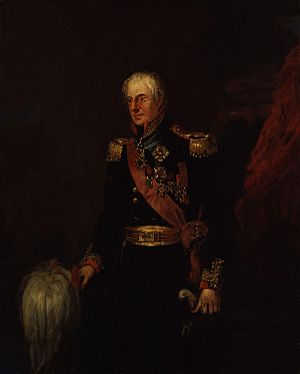Alexander Dickson (British Army officer) facts for kids
Quick facts for kids
Sir Alexander Dickson
|
|
|---|---|
 |
|
| Born | 3 June 1777 Sydenham House, Roxburghshire |
| Died | 22 April 1840 (aged 62) London |
| Buried |
Plumstead old churchyard, Plumstead, Middlesex
|
| Allegiance | |
| Service/ |
|
| Years of service | 1793–1840 |
| Rank | Major general |
| Battles/wars | Napoleonic Wars War of 1812 |
| Awards | Knight Grand Cross of the Order of the Bath Knight Commander of the Royal Guelphic Order |
| Relations | General Sir Collingwood Dickson (son) |
Sir Alexander Dickson (born June 3, 1777, died April 22, 1840) was a very important officer in the British Army. He was an expert in artillery, which means he knew a lot about cannons and big guns. He fought in many major battles during the Napoleonic Wars. The famous Duke of Wellington, a top general, trusted him greatly. Wellington even put him in charge of all the artillery for his army during the later part of the Peninsular War.
Contents
Early Military Life
Alexander Dickson joined the Royal Military Academy in 1793. He became a second lieutenant in the Royal Artillery the next year. As a young officer, he served in Menorca in 1798. He also saw action in Malta in 1800.
As a captain, he took part in the Montevideo Expedition in 1806–07. In 1809, he went to Portugal with Brigadier General Edward Howorth. There, he worked as a brigade-major for the artillery.
Leading Artillery in the Peninsular War
Dickson soon took command of the Portuguese artillery. As a lieutenant colonel in the Portuguese army, he fought in many battles from 1810 to 1811. He became very skilled at planning artillery attacks.
Key Sieges and Battles
The Duke of Wellington gave Dickson important tasks during several sieges. These included the sieges of Ciudad Rodrigo, Badajoz, the Salamanca forts, and Burgos. He was in charge of the reserve artillery at the Battle of Salamanca.
Eventually, he commanded all the artillery for the allied army. Even though he was still a captain in the British army, he led about 8,000 soldiers. He played a huge role in the successful Siege of San Sebastián in 1813. He also directed artillery movements at the battles of Vitoria, the Pyrenees, and Toulouse.
After the war, officers who served under him gave him many gifts. Many of these officers were actually older and had higher ranks than him. This showed how much they respected his skills.
Other Campaigns
Dickson was also present at the difficult Battle of New Orleans. He then returned to Europe just in time for the Waterloo campaign. He was part of Wellington's artillery staff at Quatre Bras and Waterloo. Later, he commanded the British cannons during the sieges of French fortresses.
For the rest of his life, he worked in Britain. He served as a high-ranking artillery staff officer. He held the title of Master Gunner St James's Park.
His Medals and Recognition
During the Peninsular War, he fought in many important battles. These included Busaco, Albuera, Ciudad Rodrigo, Badajoz, Salamanca, Vittoria, San Sebastián, Nivelle, Nive, and Toulouse.
His Peninsular Gold Medal had six clasps. Only a few other officers had more clasps. The Duke of Wellington had nine, and Sir Dennis Pack and Lord Beresford each had seven. This shows how many major battles Dickson was involved in.
Later Life and Legacy
Sir Alexander Dickson passed away in 1840. He was a major general and had received the high honor of Knight Grand Cross of the Order of the Bath. A memorial was built for him in Woolwich in 1847. He was also one of the first members of the Royal Geographical Society.
His personal diaries from the Peninsular War were very important. They were used as a main source for a book called "Duncan's History of the Royal Artillery."

